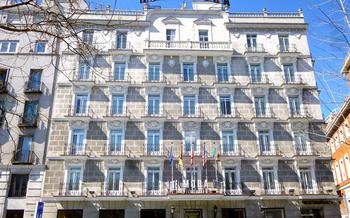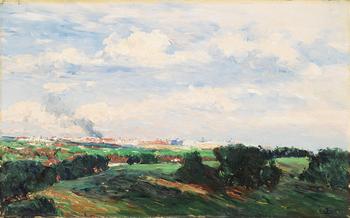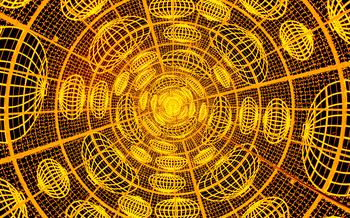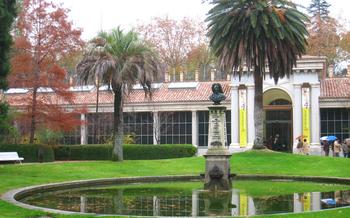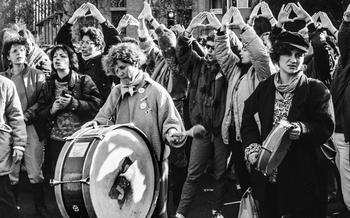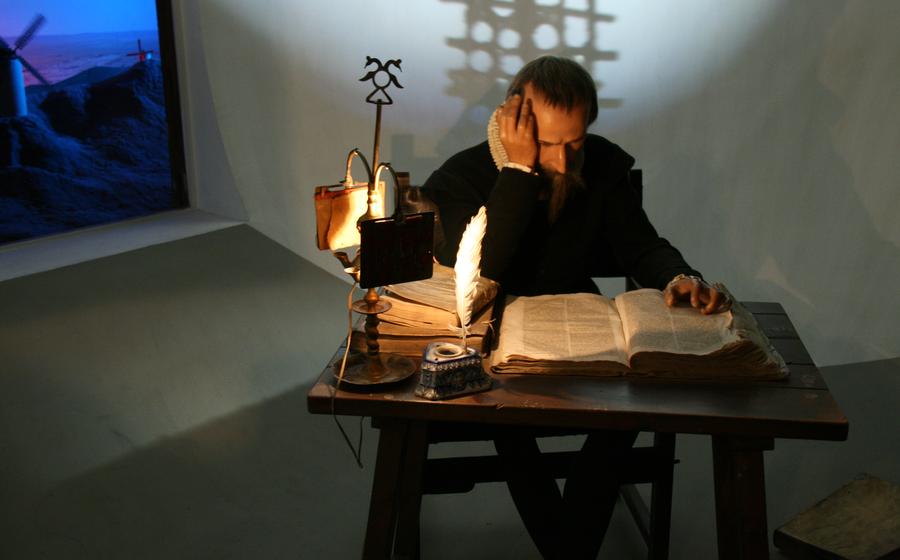
Wax Museum of Madrid
- Museo de Cera de Madrid: A Journey Through Time and History
- Historical Figures and Personalities
- Entertainment and Education
- Spanish Culture and Traditions
- Unique Exhibitions and Displays
- Interactive Experiences and Photo Opportunities
- Museum Shop and Souvenirs
- Nearby Attractions and Points of Interest
- Historical Context and Significance of Wax Museums
- Educational Programs and Workshops
- Conservation and Preservation Efforts
- Special Events and Exhibitions
- Insider Tip: Hidden Gems and Photo Spots
Museo de Cera de Madrid: A Journey Through Time and History
Nestled in the heart of Madrid, Spain, the Museo de Cera de Madrid, also known as the Madrid Wax Museum, invites visitors on a captivating journey through time and history. Founded in 1972, this remarkable museum boasts an impressive collection of over 450 lifelike wax figures, meticulously crafted to showcase iconic historical figures, celebrities, and fictional characters. Step into the museum's grand halls and prepare to be awestruck by the sheer artistry and attention to detail that bring these figures to life.
The Museo de Cera de Madrid is renowned for its comprehensive representation of Spanish and world history. Visitors can stroll through the halls and encounter legendary figures from different eras, including royalty, politicians, artists, scientists, and religious leaders. Each wax figure is accompanied by informative panels that provide historical context and insights into the lives of these notable individuals. The museum's layout is designed to create a seamless flow, allowing visitors to navigate through various sections dedicated to different themes and periods in history.
Historical Figures and Personalities
The Museo de Cera de Madrid's collection of wax figures showcases a diverse range of historical personalities who have shaped Spanish and world history. From ancient rulers to modern-day icons, the museum provides a unique opportunity to learn about their lives and contributions.
One of the most notable figures in the collection is King Philip II, the powerful monarch who ruled Spain during the 16th century. His wax figure captures his stern expression and regal demeanor, reminding visitors of his pivotal role in shaping the Spanish Empire.
Another highlight is the figure of Queen Isabella I, known as Isabella the Catholic. Her wax replica portrays her intelligence and determination, which led to the unification of Spain and the sponsorship of Christopher Columbus's voyage to the Americas.
The museum also features wax figures of renowned artists, writers, and scientists who have left an indelible mark on Spanish culture. From the painter Pablo Picasso to the writer Miguel de Cervantes, these figures bring to life the creative spirit and intellectual achievements of Spain.
Each wax figure is meticulously crafted to capture the essence of the individual it represents, creating a lifelike and immersive experience for visitors. Whether you're interested in history, culture, or art, the Museo de Cera de Madrid offers a fascinating journey through the lives of some of the world's most influential figures.
Entertainment and Education
The Museo de Cera de Madrid offers a unique blend of entertainment and education, making it a suitable destination for visitors of all ages and interests. Beyond the captivating wax sculptures, the museum features interactive elements and educational programs that enhance the visitor experience.
Interactive touchscreens and multimedia displays provide in-depth information about the historical figures and events depicted in the wax figures. Visitors can learn about the lives, achievements, and impact of these individuals through interactive quizzes, games, and educational videos.
The museum also offers guided tours led by knowledgeable staff who provide insights into the history and significance of the wax figures. These tours are available in multiple languages, ensuring that international visitors can fully appreciate the museum's collection.
Families with young children will find the museum's educational programs particularly engaging. Workshops and activities designed for different age groups allow children to learn about history, art, and culture through hands-on experiences. These programs often include interactive storytelling, craft activities, and role-playing, making learning fun and memorable for kids.
Whether you're a history buff, an art enthusiast, or simply looking for a fun and educational experience, the Museo de Cera de Madrid has something to offer everyone.
Spanish Culture and Traditions
The Museo de Cera de Madrid is not just a showcase of historical figures; it also offers a glimpse into the vibrant culture and traditions of Spain. Visitors can marvel at wax figures dressed in traditional costumes from different regions of the country, showcasing the diversity and richness of Spanish culture. The museum also features scenes depicting traditional festivals and historical events, providing visitors with an immersive experience of Spanish customs and heritage.
One of the highlights of the museum's collection is the representation of Spanish arts, music, and literature. Visitors can see wax figures of renowned artists such as Salvador Dalí and Pablo Picasso, as well as musicians like Paco de Lucía and flamenco dancers in full regalia. The museum also pays tribute to literary giants like Miguel de Cervantes and Federico García Lorca, showcasing their contributions to Spanish culture.
Through its collection of wax figures and interactive displays, the Museo de Cera de Madrid serves as a valuable resource for anyone interested in exploring the rich tapestry of Spanish culture. Visitors can gain insights into the traditions, customs, and artistic achievements that have shaped the identity of this vibrant nation.
Unique Exhibitions and Displays
Beyond its historical figures, the Museo de Cera de Madrid showcases unique exhibitions and displays that captivate visitors. One such highlight is the "Spanish Cinema Hall," which immortalizes legendary figures from the golden age of Spanish cinema. Visitors can admire wax recreations of iconic actors and actresses, transported back in time to the glamour and excitement of the silver screen.
Another captivating display is the "Hall of Horrors," a thrilling journey into the realm of the macabre. Here, visitors encounter wax figures depicting infamous criminals, terrifying monsters, and spine-chilling scenes from horror movies. The museum's attention to detail in these displays is truly remarkable, immersing visitors in an eerie and unforgettable experience.
One of the most poignant exhibits is the "Hall of Mirrors," which pays tribute to the victims of the 2004 Madrid train bombings. This moving display features wax figures of real people who lost their lives in the tragedy, honoring their memory and reminding visitors of the devastating impact of terrorism.
Interactive Experiences and Photo Opportunities
The Museo de Cera de Madrid offers a range of interactive elements and photo opportunities that enhance the visitor experience and create memorable moments. Visitors can pose with wax figures of their favorite historical figures, creating a fun and educational opportunity to capture their visit. The museum also features interactive displays that allow visitors to learn more about the history and significance of the figures on display.
For example, visitors can stand next to a wax figure of Christopher Columbus and learn about his voyages of exploration, or they can pose with a wax figure of Queen Isabella I of Castile and learn about her role in Spanish history. The museum also features a green screen photo booth where visitors can pose with a variety of backgrounds, creating a unique and personalized souvenir of their visit.
To make the most of the interactive features and photo opportunities, visitors should come prepared with their cameras or smartphones. It's also a good idea to take your time and explore the museum at a leisurely pace, allowing yourself plenty of time to interact with the displays and capture the perfect photos.
Museum Shop and Souvenirs
The Museo de Cera de Madrid's gift shop is a treasure trove of unique and memorable souvenirs that visitors can take home to remember their visit. The shop offers a wide range of items, including replicas of wax figures, historical artifacts, and traditional Spanish handicrafts.
One of the most popular souvenirs is a miniature wax figure of a famous historical figure. Visitors can choose from a variety of figures, including Spanish royalty, world leaders, and cultural icons. These miniature figures are meticulously crafted and make for a unique and treasured memento of a visit to the museum.
The shop also sells a variety of books, postcards, and other printed materials related to the museum's collection and the history of wax figures. These items are a great way to learn more about the museum and its exhibits and to share the experience with friends and family members who were unable to visit.
For those looking for a more traditional souvenir, the shop offers a variety of handcrafted items made by local artisans. These items include pottery, glassware, jewelry, and textiles. These souvenirs are not only beautiful but also support the local economy and help to preserve traditional Spanish craftsmanship.
The museum shop is a great place to find the perfect souvenir to remember your visit to the Museo de Cera de Madrid. Whether you are looking for a miniature wax figure, a historical artifact, or a traditional Spanish handicraft, you are sure to find something special in the shop.
Nearby Attractions and Points of Interest
Located in the heart of Madrid, the Museo de Cera de Madrid is surrounded by a wealth of other cultural attractions and points of interest. Just a short walk away, visitors can explore the iconic Plaza Mayor, a beautiful square lined with historic buildings and vibrant restaurants. The nearby Palacio Real de Madrid, the official residence of the Spanish royal family, is a must-see for history buffs. For art enthusiasts, the world-renowned Prado Museum, home to masterpieces by Goya, Velázquez, and El Greco, is a short distance away. To experience the vibrant energy of Madrid, take a stroll along the lively Gran Vía, a bustling shopping and entertainment street. These nearby attractions offer a diverse range of experiences, allowing you to create a memorable itinerary that combines history, art, and culture. Plan a day of exploration, starting with a visit to the Museo de Cera de Madrid, and then venture out to discover the other treasures that this vibrant city has to offer.
Historical Context and Significance of Wax Museums
Wax museums have a rich and fascinating history, dating back to the 16th century when they were first used to display religious figures and scenes. Over time, wax museums evolved into popular attractions, showcasing historical figures, celebrities, and events from around the world. These museums played a crucial role in preserving and showcasing historical figures and events, making them accessible to the general public.
The Museo de Cera de Madrid is one of the most notable wax museums in the world, with a collection that spans centuries of history. The museum has been instrumental in preserving Spanish cultural heritage and showcasing influential figures from Spanish and world history. Through its collection, the museum offers visitors a unique opportunity to see and interact with historical figures, gaining insights into their lives and contributions.
The Museo de Cera de Madrid has also been at the forefront of innovation in the field of wax museums. The museum has incorporated interactive elements and educational programs to enhance the visitor experience and provide a deeper understanding of Spanish history and culture.
Overall, the Museo de Cera de Madrid stands as a testament to the historical significance of wax museums. The museum's collection and its dedication to preserving and showcasing Spanish cultural heritage make it a must-visit attraction for anyone interested in history, art, or culture.
Educational Programs and Workshops
The Museo de Cera de Madrid offers a range of educational programs and workshops designed to engage and inspire visitors of all ages. These programs are tailored to different age groups and interests, providing interactive and hands-on experiences that bring history and culture to life.
For younger visitors, the museum offers workshops on topics such as costume design, wax sculpting, and historical storytelling. These workshops allow children to learn about the museum's collection and engage with its exhibits in a fun and creative way.
Older students and adults can participate in more in-depth workshops and lectures on topics such as Spanish history, art, and literature. These programs provide a deeper understanding of the historical figures and events depicted in the museum's wax figures.
The museum also collaborates with schools and educational institutions to develop custom programs that align with specific curricula and learning objectives. These programs can be tailored to meet the needs of different grade levels and subject areas.
Participants in these educational programs often come away with a newfound appreciation for Spanish culture, history, and art. The museum's interactive and engaging approach to education makes learning fun and memorable for visitors of all ages.
Conservation and Preservation Efforts
The Museo de Cera de Madrid is committed to preserving its collection of wax figures for future generations. The museum employs a team of conservators who work tirelessly to maintain and restore the delicate sculptures. The conservation process involves a variety of techniques, including cleaning, repairing, and retouching. The conservators also work to prevent damage to the figures by controlling the temperature and humidity levels in the museum.
One of the biggest challenges facing the conservators is the fact that wax is a fragile material. It is susceptible to damage from heat, light, and humidity. The conservators must take great care when handling and storing the wax figures to avoid causing any damage.
The Museo de Cera de Madrid's conservation efforts are essential to ensuring that the museum's collection remains intact for future generations. The conservators' work is a testament to the museum's commitment to preserving its cultural heritage.
Anecdote:
One of the most challenging conservation projects undertaken by the museum was the restoration of the wax figure of King Alfonso XIII. The figure had been damaged in a fire, and the conservators had to painstakingly repair the damage without compromising the integrity of the sculpture. The restoration process took several months, but the conservators were able to successfully restore the figure to its former glory.
Special Events and Exhibitions
The Museo de Cera de Madrid is not just a static display of wax figures; it also hosts a variety of special events and temporary exhibitions throughout the year. These events and exhibitions offer unique experiences and insights that enhance the visitor's understanding of Spanish history, culture, and art.
One of the most popular events is the annual "Noche del Terror" (Night of Terror), held around Halloween. During this event, the museum transforms into a haunted house, complete with spooky decorations, live actors, and special effects. Visitors can explore the museum's dark corridors and encounter terrifying creatures lurking around every corner.
The museum also hosts temporary exhibitions that focus on specific themes, artists, or historical figures. These exhibitions often feature new wax figures created specifically for the occasion. Past exhibitions have explored topics such as the history of Spanish cinema, the life of Pablo Picasso, and the Spanish Civil War.
Special events and exhibitions at the Museo de Cera de Madrid offer a unique opportunity to experience the museum in a different light. They provide visitors with a deeper understanding of Spanish culture and history, while also creating memorable and exciting moments.
Insider Tip: Hidden Gems and Photo Spots
As you explore the Museo de Cera de Madrid, keep an eye out for hidden gems and photo spots that will make your visit even more memorable. One such gem is the "Secret Room," a small, dimly lit chamber tucked away in a corner of the museum. Here, you'll find a collection of wax figures depicting historical figures involved in clandestine activities or hidden aspects of history. It's a fascinating and lesser-known part of the museum that's worth seeking out.
For photo enthusiasts, there are several spots within the museum that offer unique perspectives and Instagram-worthy moments. The grand staircase, with its sweeping curves and intricate details, is a popular spot for capturing dramatic shots. The Hall of Mirrors, with its rows of reflective surfaces, creates an infinite and visually stunning backdrop for photos. And don't miss the outdoor courtyard, where you can capture the museum's beautiful facade against the backdrop of the Madrid sky.
To make the most of your photo opportunities, consider visiting the museum during the golden hours of sunrise or sunset, when the natural light casts a warm and flattering glow on the wax figures. Experiment with different angles and perspectives to create unique and eye-catching shots. And don't forget to have fun and let your creativity shine!
